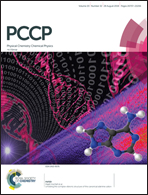A molecular level study of the phase transition process of hydrogen-bonding UCST polymers†
Abstract
Most of the existing studies have focused on the development of the lower critical solution temperature (LCST) behavior of thermoresponsive polymers, whereas research on the upper critical solution temperature (UCST) behavior from a molecular point of view is extremely rare. In this work, a molecular level study of the UCST thermal transition of poly-N-acryloylglycinamide (PNAGA)-based polymers in water and in a water/methanol mixture (χm = 6.9 mol%) was performed. Turbidimetric measurements revealed the increased UCST and enlarged hysteresis of the thermal transition of the polymers with the addition of methanol. Fourier transform infrared (FTIR) spectral analysis indicated that the increased hydrophilicity among the C–H groups along the polymer chains upon heating induced the UCST-type transition of the polymers in water, while the hydrogen bonding transformation predominated the thermal transition in the mixture. Moreover, in combination with two-dimensional correlation spectroscopy (2Dcos), the structures with different types of inter/intramolecular hydrogen bonds formed among the NAGA units have been distinguished and the transformation of the amide groups in PNAGA-based polymers from C![[double bond, length as m-dash]](https://www.rsc.org/images/entities/char_e001.gif) O⋯D–N hydrogen bonds to C
O⋯D–N hydrogen bonds to C![[double bond, length as m-dash]](https://www.rsc.org/images/entities/char_e001.gif) O⋯D2O ones during the UCST-type transition upon heating was captured.
O⋯D2O ones during the UCST-type transition upon heating was captured.

- This article is part of the themed collection: 2018 PCCP HOT Articles


 Please wait while we load your content...
Please wait while we load your content...